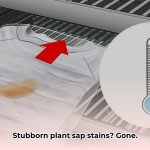Don’t panic if you’ve gotten tree sap on your clothes! While sticky and stubborn, sap is usually removable with the right techniques. This guide provides step-by-step instructions, helpful tips, and troubleshooting advice to restore your sap-stained garments.
De-Sticking Your Clothes: Step-by-Step
1. Identify the Sap and Fabric
First, determine the type of sap (e.g., pine, maple) as this can influence its stickiness. Also, consider the fabric type, as delicate materials require gentler treatment.
2. Freeze and Scrape (For Hardened Sap)
If the sap is hardened, place the garment in the freezer for an hour or two. This will make the sap brittle and easier to remove. Gently scrape off as much as possible using a dull knife, spoon edge, or even a credit card.
3. Choose Your Sap-Busting Weapon
Several methods work well, depending on the fabric and sap type:
- Rubbing Alcohol (Isopropyl Alcohol): Effective for many fabrics, but test on a hidden area first. Apply with a cotton ball, working from the stain’s outer edge inwards.
- Hand Sanitizer: A convenient on-the-go solution. Apply a small amount to the stain and blot gently. May not be suitable for all fabrics.
- Dish Soap (Like Dawn): Known for its grease-fighting power. Apply a few drops, gently rub, and let sit for 15-20 minutes before rinsing.
- Peanut Butter: The oils in peanut butter can help loosen sap. Apply a thin layer, let it sit for an hour, then scrape off the peanut butter and sap. Wash the area with dish soap afterwards.
- Heavy-Duty Laundry Detergent: Pre-treat the stain with detergent and let it sit for 30 minutes before laundering.
- Enzyme-Based Stain Remover: Specifically designed to break down organic stains like sap. Follow product instructions carefully.
- Sunscreen: Some experts suggest that the oils in sunscreen can loosen sap. Apply, rub gently, and then wash.
4. Rinse and Launder
After pre-treating, rinse the garment thoroughly with cool water. Launder as usual, using the hottest water recommended for the fabric (check the care label!).
5. Air Dry
Avoid putting the garment in the dryer until the stain is completely gone, as heat can set the stain permanently. Air dry until you’re sure the sap is gone.
Sap Removal Method Comparison
| Method | Likely Effectiveness | Suitable Fabrics | Materials Needed |
|---|---|---|---|
| Rubbing Alcohol/Sanitizer | High | Most, test on colors & delicates | Alcohol/Sanitizer, Cotton Ball/Cloth |
| Laundry Detergent | High | Most | Detergent, Soft Brush |
| Dish Soap | Medium | Most | Dish Soap, Soft Brush |
| Peanut Butter | Medium | Durable Fabrics | Peanut Butter, Knife/Spoon, Laundry Detergent |
| Enzyme Stain Remover | High | Most, follow product instructions | Enzyme Stain Remover |
| Sunscreen | Medium | Most, test in hidden area | Sunscreen |
Troubleshooting
- Stain persists: Repeat the chosen method or try a different one. For lingering discoloration, consider a commercial stain remover (test on a hidden area first).
- Discoloration: This suggests the cleaning solution may have affected the fabric dye. Consult a professional cleaner for advice.
Prevention Tips
- Protective Clothing: Wear long sleeves, pants, or an apron when working or playing near trees that produce sap.
- Fabric Protector: Apply a fabric protector spray to your clothes for added defense.
- Awareness: Be mindful of your surroundings and avoid brushing against trees.
FAQs
- What about dried sap? Freezing the garment can harden the sap for easier scraping. Oils (like peanut butter or even cooking oil) can also help soften dried sap.
- Can I use these methods on delicates? Exercise caution with solvents on delicate fabrics. Always test in a hidden area first, and consider professional cleaning for valuable items.
- Eco-friendly options? Vinegar, baking soda paste, and dish soap are generally considered eco-friendly options.
Removing tree sap can require a bit of patience, but with these tips, you’re well-equipped to tackle the stickiest of situations and save your clothes. Ongoing research continually explores new cleaning methods, so stay tuned for further advancements. If you have valuable or delicate items, consulting a professional cleaner is always a wise choice.
- How Much Do Wellness Programs Cost Businesses To Offer? - December 16, 2025
- Wellness Fair Ideas for Work to Boost Employee Wellbeing - December 15, 2025
- Affordable Employee Wellness Fair Ideas for Any Budget - December 14, 2025
















